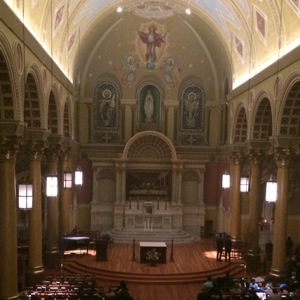 HERE ARE TIMES when everything comes together. The congregation sings robustly, the celebrant is wonderful, and the choir sounds beautiful. That does not mean that everything was perfect, but it’s a sign that everyone is doing their job. It’s a sign of progress made when built upon previous hard work. It’s an example of full and active participation—participatio actuosa—participation that is richly external and internal.
HERE ARE TIMES when everything comes together. The congregation sings robustly, the celebrant is wonderful, and the choir sounds beautiful. That does not mean that everything was perfect, but it’s a sign that everyone is doing their job. It’s a sign of progress made when built upon previous hard work. It’s an example of full and active participation—participatio actuosa—participation that is richly external and internal.
How is this achieved? There is no one answer because it can only be achieved through teamwork. The priest cannot do it alone. Nor can the choir, or the congregation or any other ministers of the liturgy. Nor does it come about in a single instant.
Holy Week at St. Cecilia Parish in Boston was such an example. The congregation sang more loudly than I had ever heard in twenty-five years—which is saying a lot. Many times, the lines between choir and congregation were blurred. The faithful in the pews clearly took over at times as the “leader of song.”
There are many factors that contributed to this, but I will name a few:
1. THE INTENTIONALITY OF THE FAITHFUL
This includes not only the congregation but also the choir and all ministers of the liturgy. The faithful who come to worship are putting in a great deal of their own effort and energy. They listen intently. They respond intently. They pray passionately. They want to be there. They want to be nourished by the Word, by the liturgy.
2. THE MASS IS SUNG.
A priest who sings injects energy into liturgy. It is well-known that the best way to jumpstart congregational singing is to sing the dialogues—sing the mass. Singing the Presidential texts recto tono with a simple “Amen” response will go a long way to energize the liturgy while infusing greater reverence. (Reverence and energy are not mutually exclusive.)
Rev. James Flavin, the Episcopal Vicar of the Central Region in the Archdiocese of Boston, was the celebrant throughout Holy Week. His voice is not, shall we say…stellar…but he was clear, practiced, and confident. I would much prefer that he sing than not. As such, we ended up singing most of the mass (Ordinary Form). It was easier to list what was not sung.
Furthermore, unaccompanied music tends to illicit greater congregational response. With the unaccompanied dialogues, Missal Chants, and simple Gregorian melodies, new and ancient, this holy building shook with joy!
3. RUBRICS WERE FOLLOWED FAITHFULLY WITHOUT FEELING “STIFF”
The rubrics were followed faithfully, but without feeling stiff or forced in any way. It felt natural. And it should, if one is prepared and knows what is coming next. Secondly, musicians and ministers of the liturgy ere likewise prepared. It wasn’t perfect, but if a glitch arose, one can recover more quickly from it if prepared.
As I’ve written many times, following the rubrics is not the end, but the means. Following them opens the door for the Roman Rite to do what it is intended to do. It is not an obstacle, but an open pathway to “…the Glory of God and the edification and sanctification of the faithful.” (Tra le Sollecitudini, General principles §1)
4. PREPARATION OF THE CHOIR
Preparation time for choirs will vary for each choir’s needs and the demands placed upon it. We begin preparation at least a month prior to Holy Week, with significant rehearsals prior to certain liturgies. Doing so is akin to know knowing the rubrics. Learn the technical aspects of the music well, so that one may begin to infuse beautiful interpretation, emotion, and spirit. Know the technical aspects well, and a choir may better pray the words they are singing. Know the technical aspects well enough, that the music will sound natural—not stiff: Beautiful—not hesitant, Sacred—not mundane, Universal—not muddled.
Confidence with as much of the technical details of the music as is possible—even if far from perfect—opens the door to prayer.
5. ARCHITECTURE
It is worth mentioning the great importance of church architecture. While the music must be beautiful, sacred and universal, so must the architecture. This is something we may have no control over. However, it must be noted that carpeting is the enemy of congregational singing. It makes singing, and hence the liturgy, more difficult for everyone. It increases one’s reliance upon microphones. Nor is it aesthetically more pleasing or cheaper in the long run. I am grateful to our pastor, Fr. John Unni for getting rid of all of our carpeting! This truly helps music be more sacred.

Sometimes things all come together even in imperfection. This is a gift from God. Prepare, and enter into the mystery!

